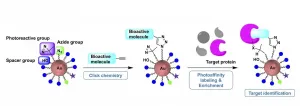Easily assembled gold nanoparticle scaffolding serves as molecular probe
2021-02-01
(Press-News.org) The development of pharmaceutical treatments is difficult -- clinicians and researchers know a certain drug can regulate particular functions, but they might not know how it actually works. Researchers at Tokyo University of Agriculture and Technology (TUAT) have developed a new, streamlined method to better understand the molecular mechanisms underpinning these interactions.
They published their approach on Dec. 17, 2020 in Organic & Biomolecular Chemistry, a journal of the U.K. Royal Society of Chemistry.
"We set out to develop a new gold nanoparticle-based method for target identification of bioactive small molecules that streamlines the current laborious steps so that we can rapidly find out how these molecules work," said Kaori Sakurai, associate professor in the Department of Biotechnology and Life Science at TUAT.
Bioactive small molecules are chemical compounds, such as pharmaceuticals, that can be readily delivered to and interact with a body's cells. By binding to specific proteins, these molecules can rewire a biological process to stop or enhance whatever the initial function was. For example, the bioactive small molecules in an anticancer agent will bind with a protein in cancer cells to inhibit their uncontrolled growth. They can even to trick the cancer cells into programmed cell death.
The challenge is that it's not always clear which proteins are being targeted or whether there are other proteins targeted that may potentially cause unwanted side effects. Using a technology called photoaffinity labeling, researchers can shine light on target proteins and instantaneously tag them, capturing and identifying them. However, photoaffinity labeling requires extensive time and resources to develop the specific tag, ensure it is attached to the right target in the cell and then purify the tagged target protein.
"Photoaffinity labeling is a powerful approach for the discovery of small molecule-target proteins," Sakurai said. "However, its routine use has been hampered by several issues, including inefficient protein labeling and subsequent purification and technical difficulties of making bioactive small molecules into suitable probes."
Sakurai's team previously provided a solution to the first issue by employing a gold nanoparticle as modular scaffolding on which a specific probe can be designed. In the recent paper, they focused on developing a one-step preparation process.
Since gold nanoparticles have surfaces that can hold modular pieces, the researchers can efficiently build customized assemblies by simply mixing building blocks, according to paper co-author Kanna Mori, a graduate student in the Department of Biotechnology and Life Science at TUAT.
"Photoaffinity probes can be easily obtained from the probe precursors, preassembled with three types of building blocks -- each containing a clickable group, a photoreactive group and a water-soluble spacer group--and then rapidly incorporate a small-molecule of interest through 'click chemistry,'" Mori said.
The fabricated small molecule, even after being conjugated to the nanoparticle, behaves as a parent molecule that would naturally bind to a protein, and the photoreactive group reacts to ultraviolet light irradiation that activates the probe. Once activated, the probe can capture and isolate a target protein.
"We demonstrated that clickable photoaffinity probe precursors will provide a rapid access to photoaffinity probes of different types of bioactive small molecules to identify their target proteins," Sakurai said.
Next, the researchers plan to explore the utility of gold-nanoparticle probes in target identification studies in live cells, expanding their work to factor in physiological conditions. They also plan to introduce complex natural products and some pharmaceuticals into the gold-nanoparticles to begin identifying their unknown target proteins.
INFORMATION:
The Japan Society for the Promotion of Science supported this work.
For more information about the Sakurai laboratory, please visit http://web.tuat.ac.jp/~sakurai/
Original publication:
Clickable gold-nanoparticles as generic probe precursors for facile photoaffinity labeling application. Kanna Mori and Kaori Sakurai. Organic & Biomolecular Chemistry, 2021
https://doi.org/10.1039/D0OB01688H
About Tokyo University of Agriculture and Technology (TUAT):
TUAT is a distinguished university in Japan dedicated to science and technology. TUAT focuses on agriculture and engineering that form the foundation of industry, and promotes education and research fields that incorporate them. Boasting a history of over 140 years since our founding in 1874, TUAT continues to boldly take on new challenges and steadily promote fields. With high ethics, TUAT fulfills social responsibility in the capacity of transmitting science and technology information towards the construction of a sustainable society where both human beings and nature can thrive in a symbiotic relationship. For more information, please visit http://www.tuat.ac.jp/en/.
Contact:
Kaori Sakurai, Ph.D.
Associate Professor
Department of Biotechnology and Life Science
Tokyo University of Agriculture and Technology (TUAT), Japan
[Attachments] See images for this press release:

ELSE PRESS RELEASES FROM THIS DATE:
2021-02-01
In a review of national firearm data spanning more than 20 years, researchers at Oregon Health & Science University have identified alarming trends regarding increasing rates of firearm-related deaths among some of America's youngest residents.
According to lead researcher Archie Bleyer, M.D., the rate of unintentional firearm deaths in children ages 1 - 4 increased exponentially at an average annual percent of 4.9 between 1999 and 2018, with the greatest impact among non-Hispanic Black and White children. This rate is more than eight times higher than any other highly developed country ...
2021-02-01
You can't have your cake and eat it too, as the saying goes. But what if you could save your slice while enjoying the benefits at the same time? New research suggests this is possible when it comes to marine reserves.
Marine protected areas (MPAs) are among the best conservation tools at our disposal today. However, by their very nature, these reserves take away fishing grounds, which can make them unattractive to commercial fishermen. Scientists and resource managers often promote MPAs as beneficial for the fishery. In theory, they provide a refuge for stocks to rebuild and spill over into nearby waters, leading ...
2021-02-01
More fully appreciating family and engaging in more conflict are among the heightened experiences during the coronavirus pandemic, according to a new UC Riverside study.
The study from David Funder's psychology lab looked at how people experience everyday life and its situations and how those experiences change because of an extraordinary event - the global pandemic.
Undergraduate students took part in the study, which first collected responses from 544 of them in 2017, and then from 123 students during the pandemic in spring 2020, when most of the participants were sheltering at home.
The before-and-during comparison isn't all roses for pandemic living. Some everyday experiences suffer, such as conversation, finding ...
2021-02-01
The American College of Cardiology's Cardiovascular Summit will feature several poster presentations on care delivery, cost reduction and quality improvement that offer innovative concepts to combat access to care, especially during the ongoing COVID-19 pandemic and as the broader health care system works to improve health equity. Research examines the rapid adoption of virtual outpatient care, enabling rural primary care teams to improve cardiovascular health and optimizing emergency room use after clinic hours.
Summaries of embargoed abstracts are below. For access to the full abstracts ...
2021-02-01
When it comes to developing drugs for mental illnesses, three confounding challenges exist:
Men and women experience them differently, with things like depression and anxiety far more common in females.
A drug that works for one person may not work for another, and side effects abound.
New CU Boulder research, published in the journal eLIfe, sheds light on one reason those individual differences may exist. Turns out a key protein in the brain called AKT may function differently in males than females.
The study also offers a closer look at where, precisely, in the brain things may go ...
2021-02-01
Every late winter and early spring, huge dust storms swirled across the bare and frozen landscapes of Europe during the coldest periods of the latest ice age. These paleo-tempests, which are seldom matched in our modern climate frequently covered Western Europe in some of the thickest layers of ice-age dust found anywhere previously on Earth. This is demonstrated by a series of new estimates of the sedimentation and accumulation rates of European loess layers obtained by Senior Research Scientist Denis-Didier Rousseau from Ecole Normale Supérieure in Paris, France, and colleagues. The work, which is published in Quaternary Science Reviews is part of the TiPES project on tipping points in the Earth system, coordinated by The University ...
2021-02-01
LA JOLLA--(February 1, 2021) Wolffia, also known as duckweed, is the fastest-growing plant known, but the genetics underlying this strange little plant's success have long been a mystery to scientists. Now, thanks to advances in genome sequencing, researchers are learning what makes this plant unique--and, in the process, discovering some fundamental principles of plant biology and growth.
A multi-investigator effort led by scientists from the Salk Institute is reporting new findings about the plant's genome that explain how it's able to grow so fast. The research, published in the February 2021 issue of Genome Research, will help scientists to understand how plants make trade-offs between ...
2021-02-01
DALLAS, Feb. 1, 2021 -- Women with a history of diabetes during pregnancy (gestational diabetes) are twice as likely by mid-life to develop calcium in heart arteries - a strong predictor of heart disease - even if healthy blood sugar levels were attained many years after pregnancy, according to new research published today in the American Heart Association's flagship journal Circulation.
Gestational diabetes, which is high blood sugar levels (glucose intolerance) first recognized during pregnancy, affects approximately 9% of U.S. pregnancies and up to 20% worldwide. After pregnancy, women who had gestational diabetes are at higher risk of developing prediabetes or Type 2 diabetes, conditions that are risk factors ...
2021-02-01
Irvine, Calif. -- Researchers from the University of California, Irvine and the University of Minnesota have found that an enriched diet and companionship can reduce pain in mice with sickle cell disease by increasing serotonin. They also discovered that duloxetine, an antidepressant that boosts serotonin levels, could be an alternative to opioids in treating chronic pain.
"Finding safe and effective alternatives to opioids is a research priority, especially for patients with sickle cell disease," said Dr. Keith Hoots, director of the Division of Blood Diseases and Resources at the National Heart, Lung, and Blood Institute. "It's encouraging to see a dose-response relationship to nutrients and companions in mice, ...
2021-02-01
ROCHESTER, Minn. -- Researchers from Mayo Clinic and AliveCor Inc. have been using artificial intelligence (AI) to develop a mobile device that can identify certain patients at risk of sudden cardiac death. This research has yielded a breakthrough in determining the health of the electrical recharging system in a patient's heart. The researchers determined that a smartphone-enabled mobile EKG device can rapidly and accurately determine a patient's QTc, thereby identifying patients at risk of sudden cardiac death from congenital long QT syndrome (LQTS) or drug-induced QT prolongation.
The heart beats by a complex system of electrical signals triggering regular and necessary contractions. Clinicians evaluate the heart's rate-corrected QT interval, or QTc, as a vital ...
LAST 30 PRESS RELEASES:
[Press-News.org] Easily assembled gold nanoparticle scaffolding serves as molecular probe



